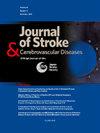相关镜像疗法对亚急性卒中患者影响较小的手的影响:一项随机对照试验。
IF 1.8
4区 医学
Q3 NEUROSCIENCES
Journal of Stroke & Cerebrovascular Diseases
Pub Date : 2025-06-10
DOI:10.1016/j.jstrokecerebrovasdis.2025.108374
引用次数: 0
摘要
背景:中风后的同侧手显示出轻微的缺陷,影响双手活动。本研究探讨了相关镜像疗法(associated mirror therapy, AMT)对脑卒中患者手部灵巧度的影响,并探讨其与卒中后双侧手部恢复的关系。方法:采用评估盲法、先导随机对照研究。患者被分配到AMT或对照组,每次接受30分钟的训练,每周五次,持续四周。主要结果为单因素盒区试验(BBT_I)。次要结果包括对照盒块检验(BBT_C)、上肢和手部Fugl-Meyer评估(FMA_UE和FMA_H)和功能独立测量(FIM)。在基线、治疗2周和治疗4周后进行评估。结果:与前两周相比,所有患者在后两周的BBT_I、FMA_H和FIM评分均有所改善。结论:AMT改善了受影响的上肢和手部运动障碍、手部灵活性和日常活动,潜在地增强了受影响较小的手卒中后的灵活性。亚急性脑卒中患者住院康复4周期间,双侧手部恢复无相关性。本文章由计算机程序翻译,如有差异,请以英文原文为准。
Effect of associated mirror therapy on the less affected hand in patients with subacute stroke: a pilot randomized controlled trial
Background
The ipsilesional hand after stroke has been shown to exhibit a minor deficit, impacting bimanual activities. This study investigates the effect of associated mirror therapy (AMT) on the less affected hand dexterity and explores the relationship between bilateral hand recovery poststroke.
Methods
An assessor-blinded, pilot randomized controlled study was conducted. Patients were assigned to the AMT or control group, receiving 30-minute training per time, five times a week for four weeks. The primary outcome was the ipsilesional Box and Block Test (BBT_I). The secondary outcomes included the contralesional Box and Block Test (BBT_C), Fugl-Meyer Assessment for Upper Extremity and Hand (FMA_UE and FMA_H), and Functional Independent Measure (FIM). Assessments were conducted at baseline, after 2-week, and 4-week treatment.
Results
All patients showed improved BBT_I, FMA_H, and FIM scores in the latter two weeks compared to the first two weeks (all P<0.05). The AMT group had higher FMA_H and FIM scores than the control group (P<0.001). Although the difference in BBT_I scores was insignificant (P=0.064), the AMT group performed better. Significant interaction effects were found in BBT_C and FMA_UE scores. The AMT group showed greater improvements in BBT_C and FMA_UE scores in 2-week and 4-week interventions than the control group (all P <0.05). Compared to the first two weeks, the AMT group showed improvements in FMA_UE and BBT_C scores during the last two weeks, while the control group only improved in FMA_UE scores (P<0.05). No correction was found in BBT_C and BBT_I change scores between bilateral hand recovery in either group during the first and the latter two weeks.
Conclusions
AMT improves affected upper limb and hand motor impairment, hand dexterity, and daily activities, potentially enhancing dexterity in the less affected hand poststroke. There is no relationship between bilateral hand recovery during 4-week inpatient rehabilitation of subacute stroke.
求助全文
通过发布文献求助,成功后即可免费获取论文全文。
去求助
来源期刊

Journal of Stroke & Cerebrovascular Diseases
Medicine-Surgery
CiteScore
5.00
自引率
4.00%
发文量
583
审稿时长
62 days
期刊介绍:
The Journal of Stroke & Cerebrovascular Diseases publishes original papers on basic and clinical science related to the fields of stroke and cerebrovascular diseases. The Journal also features review articles, controversies, methods and technical notes, selected case reports and other original articles of special nature. Its editorial mission is to focus on prevention and repair of cerebrovascular disease. Clinical papers emphasize medical and surgical aspects of stroke, clinical trials and design, epidemiology, stroke care delivery systems and outcomes, imaging sciences and rehabilitation of stroke. The Journal will be of special interest to specialists involved in caring for patients with cerebrovascular disease, including neurologists, neurosurgeons and cardiologists.
 求助内容:
求助内容: 应助结果提醒方式:
应助结果提醒方式:


